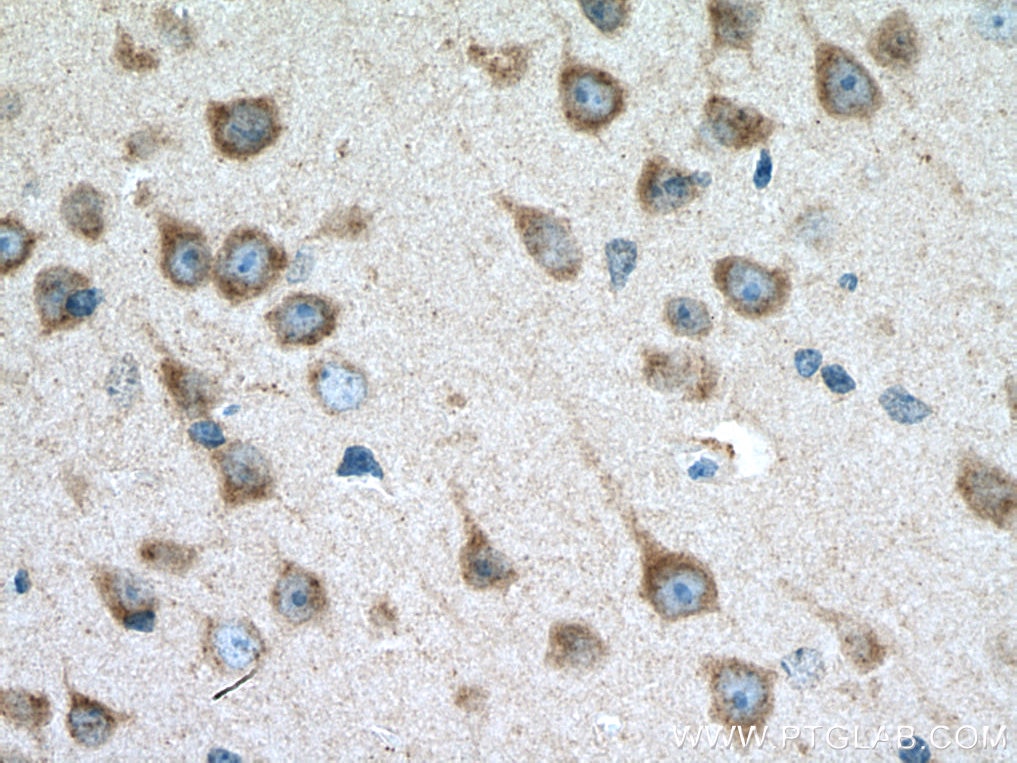Anticorps Polyclonal de lapin anti-Calsyntenin-1
Calsyntenin-1 Polyclonal Antibody for WB, IP, IHC, ELISA
Hôte / Isotype
Lapin / IgG
Réactivité testée
Humain, rat, souris
Applications
WB, IP, IF, IHC, ELISA
Conjugaison
Non conjugué
N° de cat : 12788-1-AP
Synonymes
Galerie de données de validation
Applications testées
| Résultats positifs en WB | tissu cérébral humain |
| Résultats positifs en IP | tissu cérébral de souris, |
| Résultats positifs en IHC | tissu cérébral de souris, il est suggéré de démasquer l'antigène avec un tampon de TE buffer pH 9.0; (*) À défaut, 'le démasquage de l'antigène peut être 'effectué avec un tampon citrate pH 6,0. |
Dilution recommandée
| Application | Dilution |
|---|---|
| Western Blot (WB) | WB : 1:500-1:2400 |
| Immunoprécipitation (IP) | IP : 0.5-4.0 ug for 1.0-3.0 mg of total protein lysate |
| Immunohistochimie (IHC) | IHC : 1:50-1:500 |
| It is recommended that this reagent should be titrated in each testing system to obtain optimal results. | |
| Sample-dependent, check data in validation data gallery | |
Applications publiées
| WB | See 5 publications below |
| IHC | See 1 publications below |
| IF | See 1 publications below |
Informations sur le produit
12788-1-AP cible Calsyntenin-1 dans les applications de WB, IP, IF, IHC, ELISA et montre une réactivité avec des échantillons Humain, rat, souris
| Réactivité | Humain, rat, souris |
| Réactivité citée | rat, Humain, souris |
| Hôte / Isotype | Lapin / IgG |
| Clonalité | Polyclonal |
| Type | Anticorps |
| Immunogène | Calsyntenin-1 Protéine recombinante Ag3504 |
| Nom complet | calsyntenin 1 |
| Masse moléculaire calculée | 109 kDa |
| Poids moléculaire observé | 109-130 kDa |
| Numéro d’acquisition GenBank | BC033902 |
| Symbole du gène | Calsyntenin-1 |
| Identification du gène (NCBI) | 22883 |
| Conjugaison | Non conjugué |
| Forme | Liquide |
| Méthode de purification | Purification par affinité contre l'antigène |
| Tampon de stockage | PBS avec azoture de sodium à 0,02 % et glycérol à 50 % pH 7,3 |
| Conditions de stockage | Stocker à -20°C. Stable pendant un an après l'expédition. L'aliquotage n'est pas nécessaire pour le stockage à -20oC Les 20ul contiennent 0,1% de BSA. |
Informations générales
Calsyntenins (calsyntenin-1, -2, -3) compose a family of neuronally expressed proteins that belong to the cadherin superfamily of cell adhesion molecules (PMID: 24966372; 12498782). Calsyntenin-1 (CLSTN1) is a proteolytically processed postsynaptic membrane protein with a cytoplasmic calcium-binding domain. By binding Ca2+, calsyntenin-1 may modulate Ca2+-mediated postsynaptic signals (PMID: 11161476). Calsyntenin-1 is a transmembrane cargo-docking protein for Kinesin-1-mediated vesicular transport (PMID: 16760430). It can mediate axonal transport of the amyloid precursor protein and regulate Aβ production (PMID: 22434822).
Protocole
| Product Specific Protocols | |
|---|---|
| WB protocol for Calsyntenin-1 antibody 12788-1-AP | Download protocol |
| IHC protocol for Calsyntenin-1 antibody 12788-1-AP | Download protocol |
| IP protocol for Calsyntenin-1 antibody 12788-1-AP | Download protocol |
| Standard Protocols | |
|---|---|
| Click here to view our Standard Protocols |
Publications
| Species | Application | Title |
|---|---|---|
J Neurosci The cleavage products of amyloid-beta precursor protein are sorted to distinct carrier vesicles that are independently transported within neurites. | ||
Front Oncol Long Non-coding RNA AK025387 Promotes Cell Migration and Invasion of Gastric Cancer. | ||
Cardiovasc Drugs Ther Calsyntenin-1 Promotes Doxorubicin-induced Dilated Cardiomyopathy in Rats | ||
Cell Death Discov ESRP1-driven alternative splicing of CLSTN1 inhibits the metastasis of gastric cancer | ||
J Cancer Res Clin Oncol Explore the alterations of downstream molecular pathways caused by ARID1A mutation/knockout in human endometrial cancer cells |
Avis
The reviews below have been submitted by verified Proteintech customers who received an incentive forproviding their feedback.
FH Boyan (Verified Customer) (12-09-2019) | This antibody gave a clean band around 100 kD, like that is shown in its datasheet. However, in literature, people showed that this protein runs as doublet bands at 130 - 150 kD due to its glycosylation. Therefore, this antibody is highly suspicious for recognizing another protein rather than Clstn1 itself.
|





